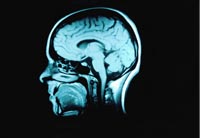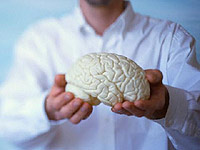The main method of diagnosing brain anomalies is magnetic resonance tomography. With this method, you can put the correct diagnosis in the early stages of the child's life. The symptoms of the brain anomalies depend on the location and prevalence of violations.
Content
Methods for diagnosing brain anomalies
 The leading role in the diagnosis of many vices of brain development belongs to magnetic resonance tomography. With this examination, it was possible to plunge into a patient with a child such abnormalities of the brain, which were not previously defined and, respectively, were not considered as the cause of neurological disorders in children.
The leading role in the diagnosis of many vices of brain development belongs to magnetic resonance tomography. With this examination, it was possible to plunge into a patient with a child such abnormalities of the brain, which were not previously defined and, respectively, were not considered as the cause of neurological disorders in children.
This method of study acquires a special value in the early deadlines of postnatal development, since during the newborn period, the disturbed state of the child with the defect of the brain is unreasonably interpreted as intrauterine meningoencephalitis, hypoxic or informant damage to the nervous system.
With the help of radiological research methods, the abnormalities of the brain development are clearly visualized, associated with a violation of the shape and structure (architectonics) of the gray substance. To a lesser extent, this concerns the disorder of the structure of the white substance. Therefore, most of the vices are associated with the anomaly of the cerebral cortex and are called generalized with cortical dysplasia.
Brain defects can develop at all stages of embryonic and partially in the fetal period. If «breaking» occurs during the 2-3rd month of intrauterine development, then rough, often occur «Visible eyes» Pokoka. To them, for example, the Holoprozencephalius (Development Pulk, in which the front brain bubble is not divided into two symmetric hemispheres, the big brain remains a single formation and the ventricular system are represented by one common cavity), which is formed in strictly fixed for its development - 22-24- y days of intrauterine development. Such abnormalities of the brain can be diagnosed without additional methods of examination, as they are conjugate with coarse specific neurological symptoms, facial dysostation (abnormal bone education or bone formation is not in those places where they must be), bone disorders.
The vices of brain development are greatest interest, which are formed due to abnormal brain development processes from the 6th to 20th week of intrauterine development. Development anomalies that are emerging in these periods received the names of dismigration disorders of the brain, or anomalies (diseases) of neural migration, transmantic dysplasia, violations of the architectonics of the brain and T.D. Often, these names and concepts are mixed with each other, and sometimes they are difficult to divide among themselves, since there is no specific symptoms for each disorder.
Researchers found «Mutation of a gene that disrupts migration and stratification of neurons when bookmarking the structures of the brain (RELN-gene, chromosome 7q22). The product of this gene is identified - Selin-Glycoprotein protein, employee «conductor» For neurons».
Basic symptoms of the disease
Dismigration disorders manifest themselves symptoms of the average and severe degree of organic damage to the nervous system. Their symptoms largely depends on the localization of violations of the structure of the brain and from their prevalence. However, pictures on magnetic resonance tomography with explicit abnormalities of the brain are not always associated with manifestations of pathological symptoms, which is currently inactive. Probably such cases are an exception to the rules that are their existence and confirm these rules. The degree of neurological disorders can affect the prevalence (area, volume) of violations of the architectonics of the brain, known in morphology as a maliance (position anomalies) and malientation (incomplete twist). Unfortunately, these changes are poorly visualized on magnetic resonance tomography.
In general, the symptoms of the brain anomalies is clearly pronounced, but a little specific. As a rule, more coarse disorders appear already in the period of the newborn, adaptation disruption, convulsive syndrome. As the child grows, psychomotor development delay, focal neurological deficit of various seventences, is often formed, often manifested in the form of cerebral paralysis. Epileptic attacks in the child appear in different age periods, but it is often happening in the first decade, they are often not amenable to therapy. Often, many syndromes are combined with each other, but can be an isolated manifestation of brain definition.
At the age of appearing epileptic attacks due to abnormalities of the brain development may affect the so-called critical period of the child's development. Not everything here is clear and understandable, but the fact that epileptic attacks appear in various age periods with a visualization of the hearth on magnetic resonance tomography, obviously.









